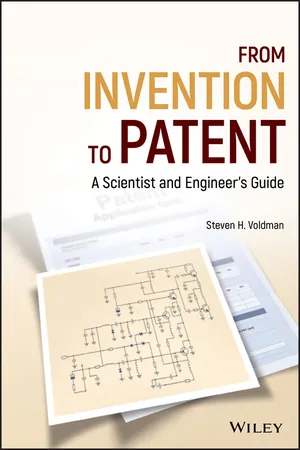
- English
- ePUB (mobile friendly)
- Available on iOS & Android
About this book
Invention and patents continues to be an important issue in technology and our global economy. Invention and Patenting provides a clear picture of how to be a prolific inventor, to understand patents, and the patent process. It provides an illuminating insight into the writing of invention disclosures to patents from the submission process to final drafts. The book shows how to communicate effectively with patent lawyers and patent examiners, teaching the language of "legalese."
This book is unique in covering both the early invention process to final patent drafting to provide high quality patents in technologies.
Key features include:
- How to become an inventor, how to invent, to what is invention;
- How to write an invention disclosure to writing a patent;
- Examples of utility, design, and plant patents;
- How to prepare the background section, brief listing of figures, detailed description of the invention, claims, abstract to artwork;
- Using patent search engines;
- Writing independent and dependent claims;
- Analyzing office actions of the US and European patent offices;
- How to write an office action response and amending claims; and,
- Examples of Office Action responses, preliminary amendments, to notice of allowance response;
Invention and Patenting is the first book by an engineer and inventor from a technologist's point of view. It is an essential reference for engineers and inventors. It is also useful for graduate and undergraduate students in technology and the sciences.
Frequently asked questions
- Essential is ideal for learners and professionals who enjoy exploring a wide range of subjects. Access the Essential Library with 800,000+ trusted titles and best-sellers across business, personal growth, and the humanities. Includes unlimited reading time and Standard Read Aloud voice.
- Complete: Perfect for advanced learners and researchers needing full, unrestricted access. Unlock 1.4M+ books across hundreds of subjects, including academic and specialized titles. The Complete Plan also includes advanced features like Premium Read Aloud and Research Assistant.
Please note we cannot support devices running on iOS 13 and Android 7 or earlier. Learn more about using the app.
Information
1
Introduction
1.1 Introduction
1.1.1 Intellectual Property
- Patents
- Trademarks
- Copyrights
- Trade secrets.

1.2 Patent
1.2.1 What Is a Patent?
1.2.2 Patents and the US Constitution
1.2.3 Why Patent?
Table of contents
- Cover
- Title Page
- Copyright
- Dedication
- Table of Contents
- About the Author
- Preface
- Acknowledgments
- 1 Introduction
- 2 Invention
- 3 Patents and Patent Languages
- 4 Patents
- 5 Patent Drawings
- 6 Claims
- 7 Office Actions
- 8 Invention Generation Methodologies
- 9 Corporate Patent Strategy
- 10 Expert Witness
- A Text for Invention Disclosure
- B Text for Invention Disclosure Reviewer Form
- C Text for Novelty Search Report
- D USPTO Office Action Details of Contents
- E USPTO Office Action Sections
- F European Union (EU) Office Action
- G European Union (EU) Office Action Response
- H US to EU Attorney Letter – Office Action Response
- I Petition for Submitting Color Photographs or Drawings
- J Patent Cooperation Treaty
- K Certificate of Correction
- L Corrected Notice of Allowance
- M Notice of Allowance
- N Preliminary Amendment
- O Submission of Corrected Drawings
- Glossary of Terms
- Index
- End User License Agreement